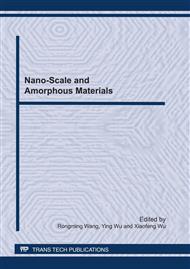p.383
p.389
p.395
p.400
p.407
p.413
p.419
p.426
p.431
The Microalloying Effects in Cu-Based Bulk Metallic Glasses
Abstract:
The glassy alloy rods of Cu50Zr43Al7, (Cu50Zr43Al7)100-xYx(x=2,5) and (Cu50Zr43Al7)100-xAgx(x=6,7) with diameters of 3.0 mm were prepared by copper mold suction casting method. The influence of adding Ag and Y to Cu50Zr43Al7 metallic glass on glass formation ability (GFA) and thermal stability was studied by means of X-ray diffraction analysis (XRD) and differential scanning calorimetry (DSC). The results show that Ag and Y appropriate micro-addition enhance the glass formation ability and thermal stability of the Cu-Zr-Al metallic glass. The effect of Ag is better than that of Y. The addition of Ag causes a increase of the reduced glass transition temperature (Trg) of (Cu50Zr43Al7)100-xAgx alloy from 0.618 at 0 at.% Ag to 0.628 at 7 at.% Ag. The width of the supercooled liquid region of Cu43Zr43Al7Ag7 glassy alloy increases about 25K compared with that of Cu50Zr43Al7, and the γ value of Cu43Zr43Al7Ag7 reaches 0.433. The electrochemical corrosion behaviors of Cu50Zr43Al7, (Cu50Zr43Al7)100-xYx(x=2,5) and (Cu50Zr43Al7)100-xAgx(x=6,7) metallic glasses in 3.5% NaCl solution were investigated by potentiodynamic polarization method. It is found that corrosion resistance of all amorphous alloys is better than that of the corresponding crystalline alloys. The Ag and Y micro-addition improve corrosion resistance of Cu50Zr43Al7 metallic glass. The corrosion current density of Cu43Zr43Al7Ag7 metallic glass decreases 1~2 orders of magnitude compared with that of Cu50Zr43Al7.
Info:
Periodical:
Pages:
407-412
Citation:
Online since:
June 2011
Authors:
Price:
Сopyright:
© 2011 Trans Tech Publications Ltd. All Rights Reserved
Share:
Citation:


